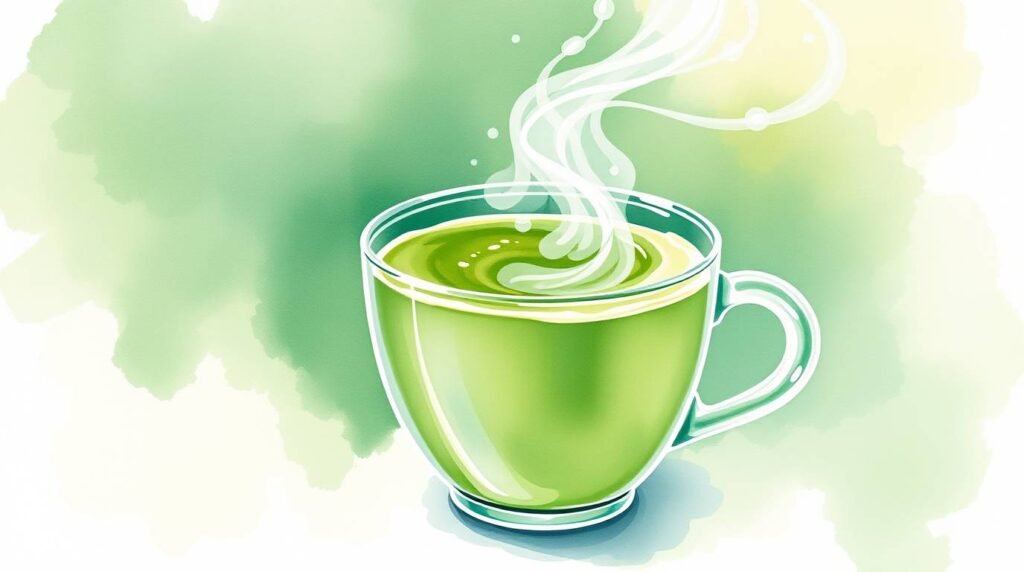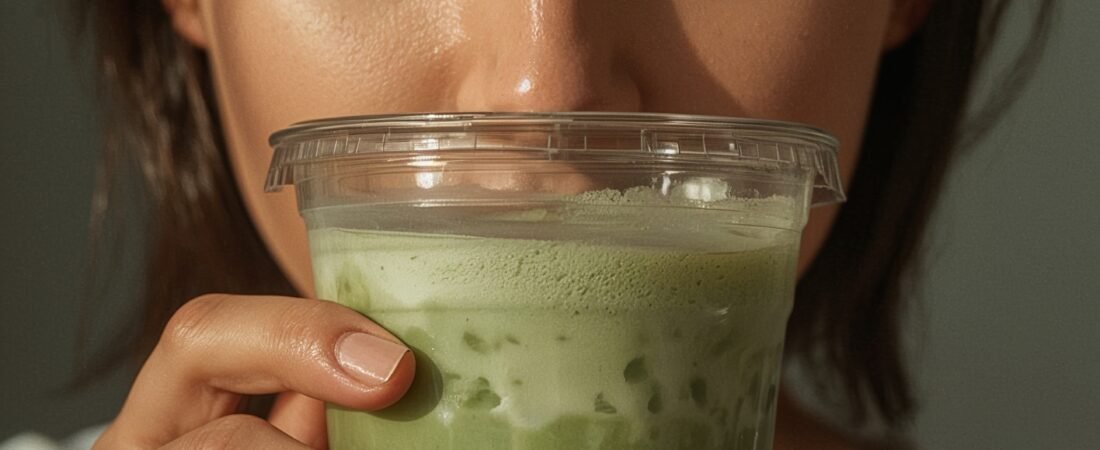Oat milk emerges as the top choice for matcha lattes, delivering the ideal balance of creaminess, frothability, and flavor compatibility with matcha’s earthy profile. This plant-based option naturally complements matcha’s umami notes while providing excellent texture for both hot and iced beverages, making it the preferred milk for cafes and home baristas alike.
What Makes a Milk Ideal for Pairing with Matcha?
Understanding matcha’s flavor profile and how milk enhances it
Matcha possesses a complex flavor profile that’s rich, grassy, slightly bitter, and packed with umami. Unlike regular green tea, matcha’s intensity comes from consuming the entire leaf, ground into a fine powder. High-grade ceremonial matcha tends to be smoother and sweeter, while culinary grades can be more robust and occasionally sharp.
Milk serves as matcha’s perfect partner by softening the edges and balancing the flavors. The proteins and fats in milk create a smooth, creamy texture that tempers matcha’s vegetal notes beautifully. This pairing transforms what can sometimes be an overwhelming taste into a harmonious, satisfying beverage that appeals to both matcha newcomers and enthusiasts.
Key factors like creaminess, frothability, and nutritional balance
The ideal milk for matcha must excel in three crucial areas. Creaminess comes from higher fat content, which helps balance matcha’s sometimes sharp or astringent notes. The fat molecules create that luxurious, velvety consistency that makes matcha lattes so appealing.
Frothing ability depends on the right balance of protein and fat. Proteins surround air bubbles during the frothing process, creating stable foam that holds its shape. Without sufficient protein, foam collapses quickly, resulting in a flat-topped latte.
The nutritional profile matters too. Matcha is already packed with antioxidants, particularly catechins and EGCG. When choosing milk, consider whether you want to add protein, calcium, vitamins, or keep calories low while maintaining the health benefits of your matcha drink.
Dairy vs. non-dairy considerations for health and taste
Dairy milk contains casein, a protein that binds to matcha’s catechins. This binding blocks the absorption of antioxidants by the body, potentially reducing some of matcha’s health benefits. For maximum antioxidant absorption, plant-based milks are the better choice.
From a taste perspective, whole dairy milk creates the gold standard for froth and provides natural sweetness. However, many find that quality plant-based alternatives can match or even exceed dairy’s performance while offering additional benefits like being easier to digest and more environmentally sustainable.
Is Oat Milk the Best Choice for Matcha Lattes?
Why oat milk’s creamy texture complements matcha
Oat milk’s naturally sweet and slightly malty flavor complements matcha’s earthiness without overpowering it. The combination creates what many describe as a perfectly balanced and satisfying flavor profile. Unlike some alternatives that can taste thin or watery, oat milk provides substantial body that makes each sip feel indulgent.
The creamy texture of oat milk enhances the earthy flavors of matcha, creating a delightful beverage. This plant-based milk contains beta-glucans, a type of fiber that contributes to its naturally thick consistency. When steamed, oat milk maintains its viscosity, creating lattes that rival traditional dairy versions in mouthfeel and satisfaction.
Pros and cons of barista-style oat milk for frothing
Among plant milks, oat milk wins hands down for frothing, especially when using a barista blend. Barista versions are specially formulated with higher protein, fat, and stabilizers that make frothing effortless. These versions create stable, long-lasting foam that holds its shapeand enables latte art.
The advantages include excellent microfoam creation and consistent results. However, some brands include added sugar or seed oils, so reading labels is important. Regular oat milk may separate in cold matcha drinks unless shaken well, and barista versions typically cost more than standard options.
How to make an oat milk matcha latte at home

Start with high-quality matcha powder sifted into a small bowl. Add 2 tablespoons of hot water (170-180°F) and whisk vigorously in an “M” or “W” motion until the matcha forms a smooth, frothy paste with no lumps.
Heat 1 cup of barista-style oat milk in a saucepan over medium heat until steaming but not boiling. Use a milk frother to create thick, creamy foam. For best results, aim for microfoam – tiny, silky bubbles rather than big ones. Pour the matcha paste into your mug, then slowly add the frothed oat milk, holding back the foam with a spoon before spooning it on top.
Does Almond Milk Pair Well with Matcha’s Earthy Notes?
The nutty flavor synergy between almond milk and matcha
The subtle nutty flavor of almond milk complements the earthy tones of matcha beautifully. This combination creates a balanced drink without overwhelming the matcha’s natural flavors. The light, slightly sweet undertones of almond milk allow matcha’s complex umami profile to shine through while adding its own delicate nuttiness.
However, success depends heavily on quality. Some almond milk brands can be overly sweet or watery, making matcha lattes taste awful. The key is choosing unsweetened versions from reputable brands that maintain proper consistency and clean flavor profiles.
Low-calorie benefits and common drawbacks like separation
Almond milk offers significant calorie advantages, typically containing 30-60 calories per cup compared to dairy milk’s 150. It’s also low in carbs and naturally low in sugar when unsweetened. For those managing weight or following low-calorie diets, almond milk enables guilt-free matcha enjoyment.
The main drawbacks include tendency to separate in hot drinks and poor frothing ability unless using barista blends. Almond milk is unstable at high temperatures and is smoother at around 55°C. Many users find regular almond milk creates thin, watery texture that lacks the richness expected in quality lattes.
Best almond milk brands for iced matcha drinks
For iced matcha beverages, almond milk performs excellently due to reduced separation issues at cold temperatures. The light, nutty profile works particularly well in iced applications where the temperature-related stability problems don’t occur.
Choose brands like Califia Farms or Silk that offer barista versions specifically designed for better performance in coffee and tea applications. Unsweetened varieties allow you to control sweetness levels while maintaining the authentic matcha taste that makes these beverages so appealing.
Can Coconut Milk Add a Tropical Twist to Matcha?
Exploring coconut milk’s sweetness and richness with matcha
Coconut milk blends beautifully with matcha, adding creaminess and subtle sweetness that balances matcha’s grassy and umami notes. The sweet and distinctly coconutty flavor either complements matcha or can overpower it depending on the ratio and formulation. This pairing creates a luxurious texture and bold color that consumers love.
The naturally sweet taste of coconut milk pairs exceptionally well with the umami taste of matcha powder. Many café chains, including Pret a Manger, successfully use coconut and rice milk combinations for their matcha lattes, particularly in iced applications where the tropical notes provide refreshing contrast.
When to use full-fat vs. light coconut milk options
Full-fat coconut milk provides the richest texture due to its high fat content, creating incredibly creamy lattes with substantial body. However, this richness can sometimes overshadow the delicate taste of matcha, making it better suited for stronger matcha preparations or those who prefer indulgent drinks.
Light coconut milk or coconut milk beverages offer lighter options that maintain coconut flavor without overwhelming matcha’s subtleties. For best results, use coconut milk for iced lattes as it does curdle at higher temperatures. The high fat, low protein content makes coconut milk poor for frothing, limiting its effectiveness in hot, frothy preparations.
Recipes for coconut matcha lattes and potential overpowering issues
For iced coconut matcha lattes, whisk 1 teaspoon of matcha with 2 tablespoons of hot water until smooth. Fill a glass with ice, add chilled light coconut milk, and slowly pour the matcha mixture for beautiful layering. The coconut flavor pairs well with stronger brewed matcha but may mask subtle ceremonial grade varieties.
The challenge is getting the flavor balance right – too much coconut fades matcha, too little loses the tropical twist. Start with light coconut milk or dilute full-fat versions to find your preferred intensity. Consider using coconut milk as part of a blend with oat or almond milk for more balanced flavor profiles.
Why Choose Soy Milk for a Protein-Packed Matcha Drink?
Soy milk’s neutral taste and high protein content
Soy milk offers a mild and neutral flavor with a slight bean-like finish that balances well with matcha’s umami without overpowering the tea’s natural flavor. This neutrality makes it an excellent canvas for matcha’s complex taste profile. Soy milk provides high protein content (~7g per cup), most similar to dairy among plant milks.
The protein content isn’t just about nutrition – it’s crucial for texture. Soy milk has excellent frothing capacity due to its higher protein content. The protein molecules surround air bubbles, making it easy to create foam that rivals dairy milk in stability and appearance.
Frothing tips for soy-based matcha lattes
Soy milk produces smooth, consistent foam and excellent frothing ability. For best results, use fresh, cold soy milk and avoid overheating, as soy milk will curdle at higher temperatures. Keep the temperature around 150-160°F rather than the 170°F used for other milks.
Barista-style soy milk versions perform even better, containing stabilizers that improve foam structure. Steam the milk gently, creating microfoam through steady, controlled movement of the steam wand. The high protein content means soy milk holds its foam longer than most alternatives, making it excellent for latte art.
Allergy concerns and alternatives for soy-sensitive users
Soy milk may not suit those with soy allergies or thyroid concerns. Some varieties contain additives that can affect taste, and certain individuals find the beany taste overpowering. For those avoiding soy, oat milk provides similar protein levels and neutral flavor without soy-related concerns.
Alternative high-protein options include pea protein-based milks or fortified nut milks. Hemp milk also offers good protein content with neutral flavor. Always check labels for additives like carrageenan or gums that some people prefer to avoid.
Is Dairy Milk Still a Classic Option for Matcha?

How whole milk tempers matcha’s bitterness
Whole milk has a naturally sweet and round flavor that tempers matcha’s vegetal notes beautifully. The balance of protein and fat in whole milk produces silky, long-lasting foam that creates the classic café experience many expect from lattes. Dairy milk will be the richest and creamiest with the absolute best foam.
The robust flavor profile of matcha pairs remarkably well with the creaminess of whole milk, creating a rich and satisfying beverage. The fat content in whole milk aids in the absorption of fat-soluble vitamins found in matcha, such as vitamin E, creating nutritional synergy between the ingredients.
Nutritional perks and lactose intolerance drawbacks
One cup of whole milk provides ~8g of protein, calcium, vitamin D (fortified), and fat-soluble vitamins like A and K2. This nutritional profile complements matcha’s antioxidants, creating a more complete beverage from a wellness perspective.
However, dairy milk contains casein, which binds to matcha’s catechins and blocks antioxidant absorption. Additionally, dairy may not be suitable for vegans or lactose-intolerant individualsand may cause bloating or digestive discomfort for some. These limitations have driven many toward plant-based alternatives.
Comparing dairy to plant-based milks for cafe-style results
Dairy milk remains the gold standard for traditional texture and froth quality. Whole milk creates consistently excellent foam, while skim and low-fat milk produce less foam and thinner texturebut allow matcha’s flavors to come through more strongly.
Lactose-free milk works well for people with lactose intolerance while still delivering the same rich taste and froth as regular milk. For those who can consume dairy, it remains a reliable choice, though high-quality plant alternatives like barista oat milk now match dairy’s performance while offering additional benefits.
What About Blended Milks Like Almond-Coconut for Matcha?
Benefits of hybrid milks for balanced flavor and texture
Blending almond milk with oat or cashew milk can create a creamier and richer consistency that accommodates various palate preferences. These combinations allow you to customize the flavor profile and texture by leveraging the strengths of different milk types while minimizing their individual weaknesses.
Hybrid milks offer balanced flavor and texture that single milk types might not achieve alone. For example, combining almond milk’s nutty lightness with oat milk’s natural sweetness and creaminess creates a more complex, satisfying base for matcha lattes. These blends can also help address specific dietary needs while maintaining optimal taste.
Popular blends and their impact on matcha preparation
Coconut and rice milk combinations, like those used by Pret a Manger, create interesting flavor profiles that work particularly well in iced matcha applications. Almond-coconut blends provide tropical notes with nutty undertones, though careful ratios are needed to prevent overpowering matcha’s delicate flavors.
Oat-almond combinations are increasingly popular in cafés, offering oat milk’s superior frothing ability combined with almond milk’s lighter calorie profile. These blends often perform better than either milk alone, creating more robust foam structure while maintaining cost effectiveness compared to premium single-milk options.
Customizing blends based on dietary needs
For those avoiding nuts, oat-soy blends provide excellent protein and frothing capabilities. Coconut-oat combinations work well for those wanting richness without dairy, though they may require light coconut milk to prevent overwhelming matcha’s flavor.
Rice milk can be blended with other options for those with multiple allergies, though it contributes sweetness and thinness that need balancing with creamier alternatives. Experimenting with ratios allows customization based on individual taste preferences, dietary restrictions, and desired nutritional profiles.
How Does Cashew Milk Compare to Other Nuts for Matcha?
Cashew milk’s subtle creaminess and mild profile
Cashew milk is smooth and mild, blending seamlessly with matcha. Its neutral flavor allows the matcha’s earthy notes to take center stage, making it an excellent choice for those who want milk’s creaminess without competing flavors. Cashew milk contributes a rich and creamy texturethat enhances the overall matcha experience without masking its unique characteristics.
The subtle, buttery richness of cashew milk creates an indulgent mouthfeel similar to dairy milk but without lactose or casein concerns. This makes it particularly appealing for those seeking clean, wholesome taste that enhances rather than competes with matcha’s natural flavors.
Ideal uses in hot vs. cold matcha beverages
Cashew milk works well in both hot and cold applications, though its low protein content results in poor frothing ability. For hot matcha lattes, cashew milk provides excellent flavor and creaminess but won’t produce the foam that many expect from café-style drinks.
In cold matcha applications, cashew milk excels because frothing isn’t required. Its smooth consistency and neutral taste make it ideal for iced matcha lattes, smoothies, or cold-brewed matcha preparations where texture and flavor matter more than foam production.
Sourcing tips for high-quality cashew milk
Look for cashew milk made from organic, unsweetened varieties with minimal additives. Many commercial versions contain stabilizers that can affect taste, so reading ingredient lists is crucial. Store-bought options often vary significantly in consistency and flavor.
For best results, consider making fresh cashew milk at home by soaking raw cashews overnight and blending with water. This provides maximum control over consistency, sweetness, and flavorwhile avoiding preservatives and additives that might interfere with matcha’s delicate taste profile.
What Non-Dairy Milks to Avoid with Matcha and Why?
Common mismatches like overly watery or flavored milks
Overly watery plant-based milks create disappointing texture that fails to provide the creamy mouthfeel expected from quality matcha lattes. Rice milk, while naturally sweet, has a thin texture that lacks creaminess and poor frothing due to low protein, making it unsuitable for café-style presentations.
Flavored milks like vanilla can compete with matcha’s complex taste profile, overwhelming the subtle earthy and umami notes that make matcha special. Heavily sweetened varieties mask matcha’s natural flavors, defeating the purpose of using high-quality matcha powder.
Taste clashes and texture failures to watch for
Some almond milk brands have an overpowering beany taste that clashes with matcha’s vegetal notes. Very light or diluted versions of any plant milk will create thin, unsatisfying texture that makes expensive matcha taste cheap and watery.
Milk alternatives with strong flavoring agents like chocolate or strawberry obviously conflict with matcha. Even subtly flavored options can create taste clashes where neither the milk nor matcha flavor comes through clearly, resulting in muddy, confusing taste profiles.
Expert recommendations for troubleshooting pairings
Always shake plant-based milks well before use to ensure proper consistency. Test small amounts first when trying new brands, as quality varies significantly between manufacturers. Choose unsweetened varieties to maintain control over your matcha latte’s flavor profile.
When milk separates or curdles, check expiration dates and avoid adding milk to extremely hot matcha. Let tea cool slightly before adding milk, or gently warm the milk to reduce temperature shock. Stirring milk slowly into tea rather than pouring quickly helps prevent curdling and ensures better integration.
How to Test and Customize Milk Options for Your Matcha?
Step-by-step guide to experimenting with milks
Start by preparing identical matcha bases using the same powder, water temperature, and whisking technique. Use 1 teaspoon of sifted matcha powder with 2 tablespoons of hot water (170-180°F) whisked until smooth and frothy.
Test one milk type at a time in small quantities (4-6 oz) to avoid waste. Heat each milk to the same temperature and note differences in color, aroma, texture, and foam production. Take notes on flavor balance – does the milk enhance matcha’s earthiness or mask it? Document mouthfeel and aftertaste for comparison.
Create a simple rating system for categories like creaminess, flavor balance, foam quality, and overall satisfaction. This systematic approach helps identify personal preferences and makes future milk selection easier.
Adjusting ratios for sweetness, temperature, and foam
Start with standard ratios – 1 teaspoon matcha powder to 6-8 oz milk – then adjust based on desired strength. For stronger matcha flavor, increase powder or decrease milk. For milder taste, reverse the ratio.
Temperature affects both flavor extraction and milk performance. Keep matcha water around 170-180°F to avoid bitterness. Heat milk to 150-160°F for most alternatives, though some handle higher temperatures better. Barista blends generally perform better at higher temperatures.
For optimal foam, use fresh, cold milk and appropriate techniques for each type. Oat and soy milk froth well with standard methods, while almond milk requires gentler handling and may need barista formulations for decent foam.
Tools and ingredients for perfect matcha milk pairings

Essential tools include a fine-mesh sieve for sifting matcha powder, a bamboo whisk (chasen) or electric milk frother, and a small saucepan for heating milk. Digital thermometer helps maintain optimal temperatures.
Quality matcha powder makes the biggest difference. Ceremonial grade offers smoothest flavor for milk-based drinks, while culinary grade works well for stronger, sweeter preparations. Store matcha in airtight containers in cool, dry places to maintain freshness.
Stock multiple milk types for different occasions – barista oat milk for hot lattes, almond milk for iced drinks, and dairy milk for traditional preparations. Having variety allows optimization based on mood, dietary needs, and specific flavor preferences.
What Are the Health Benefits of Different Milks with Matcha?
Boosting antioxidants and nutrients through smart pairings
Matcha contains three times the amount of EGCG as other varieties of green tea, providing powerful antioxidant benefits that help reduce inflammation, support cardiovascular health, and protect against oxidative stress. Combining matcha with certain milks can enhance or complement these benefits.
Almond milk is rich in vitamin E, an antioxidant known for skin health benefits, while matcha provides catechins with anti-inflammatory properties. Together, they create a health-boosting beverage that supports overall well-being. Oat milk contributes beta-glucans, which support heart health and gut health.
Soy milk adds significant protein (~7g per cup) plus isoflavones that may support heart health. However, dairy milk’s casein protein can bind to matcha’s catechins, potentially reducing antioxidant absorption, making plant-based options preferable for maximum health benefits.
Calorie and protein comparisons across milk types
Almond milk offers the lowest calories (30-60 per cup) with minimal protein, making it ideal for weight management. Oat milk provides moderate calories (~120 per cup) with 2-3g protein plus beneficial fiber. Soy milk delivers the highest protein content (~7g) with moderate calories.
Coconut milk varies widely – light versions contain fewer calories while full-fat can exceed dairy milk’s calorie content due to high saturated fat. Cashew milk typically falls between almond and oat milk for both calories and protein content.
Dairy milk provides 8g protein and 150 calories per cup with complete amino acid profiles, but the casein interaction with matcha antioxidants may reduce overall health benefits compared to plant alternatives.
Vegan and allergy-friendly options for wellness-focused drinks
Oat milk stands out as nut-free, soy-free, and naturally creamy, making it suitable for most dietary restrictions while providing excellent texture and flavor. Rice milk serves those with multiple allergies but offers limited nutrition and thin consistency.
Soy milk provides complete proteins for vegans but must be avoided by those with soy allergies. Hemp milk offers omega fatty acids and protein for those avoiding nuts and soy. Pea protein-based milks deliver high protein without common allergens.
For maximum wellness benefits, choose unsweetened, minimally processed options with short ingredient lists. Organic varieties reduce pesticide exposure while supporting sustainable agriculture practices that align with health-conscious lifestyles.
Frequently Asked Questions About Milk and Matcha Pairings
Why does milk sometimes curdle in matcha?
Milk curdling occurs due to acidity and heat. Tea contains acids such as tannic acid that can disrupt the protein structure within milk. When exposed to an acidic environment, casein molecules lose their charge and clump together, creating the unappetizing curdles we want to avoid.
Heat exacerbates this process by providing energy to accelerate protein denaturation. Adding cold milk to very hot matcha creates perfect conditions for curdling. Most non-dairy substitutes can still curdle, including soy milk, almond milk, oat milk, coconut milk, and rice milk.
To prevent curdling, let your matcha cool slightly before adding milk, or gently warm the milkbefore combining. Stirring milk slowly into matcha rather than pouring quickly helps prevent separation and ensures better integration.
Can I use flavored milks like vanilla with matcha?
Vanilla can work beautifully with matcha when done thoughtfully. Vanilla bean paste provides the most natural and delicious vanilla flavor, while vanilla extract offers a more accessible option. The key is using vanilla as an enhancement rather than overwhelming matcha’s delicate flavor.
High-quality vanilla syrup can replace extract, but skip additional honey when using sweetened versions. Start with small amounts and adjust based on preference – the goal is creating perfect balance of earthy matcha and sweet vanilla without letting either dominate.
Avoid artificial vanilla extracts as they may not provide the same depth of flavor. Other flavored milks like chocolate or strawberry generally overpower matcha’s subtle characteristics and should be avoided for authentic matcha experiences.
What’s the best milk for iced vs. hot matcha lattes?
For hot matcha lattes, oat milk reigns supreme due to exceptional frothing ability and naturally sweet flavor that complements matcha perfectly. Soy milk also excels in hot applications with excellent foam production and neutral taste. Dairy milk remains the classic choice for traditional hot preparations.
Iced matcha lattes perform well with almond milk, which doesn’t require frothing and provides light, nutty flavor that works particularly well in cold applications. Coconut milk shines in iced drinks since it avoids the curdling issues that occur at higher temperatures.
Temperature stability matters more in hot applications – some milks that work perfectly cold will separate or curdle when heated. For versatility, barista-style oat milk performs excellently in both hot and cold preparations, making it the most reliable all-purpose choice for matcha enthusiasts.
